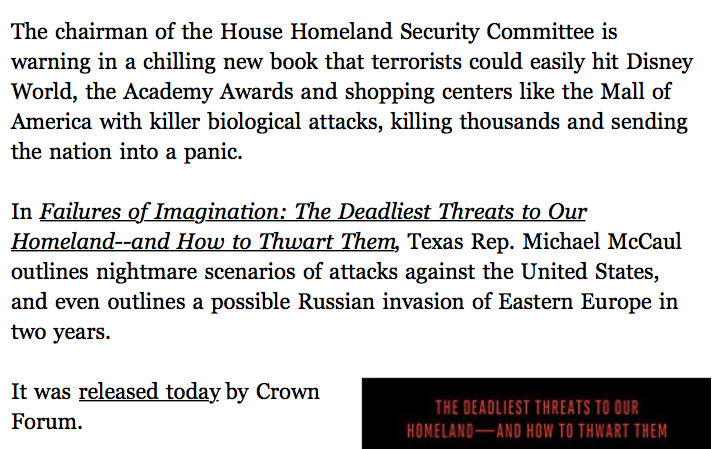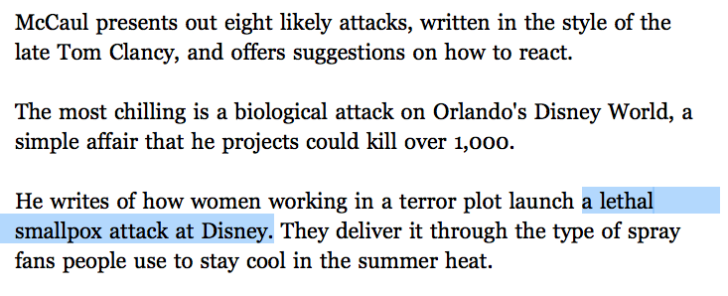Ridiculous.
The Washington Examiner reports:
I wrote about the unlikelihood of a smallpox attack years ago in two columns for FOXNews.com.
Smallpox Attack Exaggerated
By Steve Milloy
FOXNews.com, July 10, 2003
Concern over the possibility of terrorist attacks involving biological agents—especially the smallpox virus—is developing into full-fledged hysteria. Sen. Bill Frist claimed last week that a smallpox attack could kill 40 million Americans.
But a new study from the Centers for Disease Control and Prevention, slated to appear in the November-December issue of the journal Emerging Infectious Diseases and detailed here for the first time, should provide some relief to a worry-worn public.
The CDC researchers say smallpox appears much less infectious than commonly thought. This assessment calls into question the widely publicized results of last summer’s bio-terrorism war game called “Dark Winter” – a primary rationale for the current scare mongering.
Dark Winter was designed to simulate U.S. response to terrorism with smallpox. The exercise was developed by the Center for Strategic and International Studies, Johns Hopkins Center for Civilian Biodefense Studies and the ANSER Institute for Homeland Security, and held at Andrews Air Force Base near Washington, D.C. in June 2001.
Its participants, including more than a dozen current and former government officials and news media personalities, reacted to a make-believe smallpox attack.
Dark Winter began with a report that, on December 9, 2002, 24 persons reported to Oklahoma City hospitals with a strange illness. The CDC confirmed the illnesses as smallpox and the players reacted to control the epidemic. They pretended to fail so that, within two months after the epidemic started, three million cases of smallpox and one million deaths had occurred hypothetically.
Dark Winter ended with the collapse of interstate commerce, crowds rioting in the streets and the National Security Council discussing the need for martial law – a chilling scenario.
But like any other hypothetical exercise, Dark Winter is limited by the reality of its underlying rules and assumptions. One key assumption was that each person with smallpox would infect at least 10 other people and that those 10 people would each infect 10 more people and so forth. Dark Winter’s designers claimed this was a low or “conservative” assumption.
This assumption, and its use as the basis for the simulation, arises from Dark Winter participants at the Johns Hopkins Center for Civilian Biodefense Studies. Center director D.A. Henderson likes to emphasize a 1970 outbreak of smallpox in Germany where one patient appeared to infect 17 others and a 1972 outbreak in Yugoslavia where one infected person infected 38 others.
But the authors of the new CDC study regard these infection rates as extreme and unusual. They call the Yugoslavia incident “probably a record number” and describe the German incident as caused by “close sustained contact in a hospital.”
The CDC researchers looked at data from a number of different outbreaks around the world in the 1960s and 1970s. They report that most outbreaks averaged less than two persons infected per infectious person. Most outbreaks recorded less than one person infected per infectious person. In all outbreaks, some infected persons did not transmit a symptomatic case of smallpox to another person.
The researchers cite the last case of naturally occurring smallpox in October 1977 as further evidence of the difficulty for one person to infect others. Of the 161 persons who had contact with the infected person, 12 unvaccinated persons had face-to-face contact. None of the 12 became ill with clinical cases of smallpox.
Although evidence exists that one person can infect many others and that many in the U.S. are susceptible to smallpox—meaning they’ve never been exposed or vaccinated—the CDC researchers concluded “the probability that the average transmission rate will be greater than two cannot be demonstrated reliably.”
So should we blindly accept the Dark Winter scenario when the war game may have been critically flawed?
This is not to say that the possibility of bio-terrorism via smallpox should be ignored. But the hysteria grounded in Dark Winter should cease. It should be replaced with a more sober approach to the possibility of a smallpox attack.
The U.S. Government has accelerated the order of 40 million smallpox vaccines—a rationale move, and not only to squelch an epidemic. Dark Winter players believe that, “Forcible constraints on citizens may likely be the only tools when available vaccine stocks are depleted.”
Physicians, hospitals and local public health officials should be calmly reminded about the symptoms of smallpox and actions to take in case of a breakout. Channels of communication between local and national public health officials need to be improved. The sooner infected individuals can be isolated and populations can be vaccinated the sooner an epidemic can be halted.
None of these actions, however, require the public to be panicked.
Steven Milloy is the publisher of JunkScience.com, an adjunct scholar at the Cato Institute and the author of Junk Science Judo: Self-defense Against Health Scares and Scams (Cato Institute, 2001).
Small Pox Threat Exaggerated, Part II
By Steve Milloy
FOXNews.com, October 10, 2002
An epidemic of smallpox hysteria has broken out — again. Feeding the frenzy is the Bush administration’s recent announcement that the smallpox vaccine will be made available to the public.
The vaccine plan is prompted by fear of a biological attack from Iraq, which “could kill millions,” according to an Associated Press report.
First, and as detailed last year in my FoxNews.com column “Smallpox Attack Exaggerated,” the claim that millions could die in a smallpox attack relies on a gross exaggeration of smallpox’s infectiousness.
Even when the annual global smallpox death toll was 2 million — as recent as 30 years ago — the disease was endemic to 31 countries, circumstances quite different from today’s more limited bioterror scenarios.
A threshold issue is whether Iraq even has smallpox.
“I have no doubt in my mind that Iraq does have the smallpox virus,” says Dr. Ken Alibek, formerly of the Soviet bioweapons program and now with the George Mason University Center for Biodefense.
But former U.N. biological weapons inspector Jonathan Tucker says there is only inconclusive, circumstantial evidence that Iraq has smallpox, including: a 1994 find by U.N. inspectors of a freeze-dryer labeled “smallpox” in Arabic; an admission by Iraq it worked with camelpox, a relative of smallpox; and an intelligence report that some Iraqi soldiers captured during the Gulf War were vaccinated for smallpox.
This slight evidence may have convinced Dr. Alibek. But as part of the bioterror-defense industry that hardly misses an opportunity to promote the threat, Alibek’s may be convinced more easily.
The Bush administration’s top expert on smallpox, Dr. D.A. Henderson, leader of the successful global smallpox eradication effort 25 years ago, knows a bioterror attack with smallpox is unlikely.
Dr. Henderson was interviewed about smallpox last October by 60 Minutes anchor Mike Wallace: WALLACE: What about a so-called suicide bomber, someone willing to infect themselves and walk down a crowded street or through an airport?
Dr. Henderson: There are those who’ve suggested that we might have infected terrorists who might fly into the country, infected but looking perfectly well, and then developing the disease and walking all over and spreading it to people in trains or airplanes or what have you… I think it’s an improbable scenario. I think people don’t realize that first of all, smallpox does not spread until the rash begins. By the time the rash begins, I can assure you that terrorist is feeling absolutely miserable and his ability to even be mobile is very marginal. And it’d be very soon that the rash would be very noticeable and people would say, ‘What is that?’ And so I don’t think it’s a very likely scenario.
The Soviet Union weaponized smallpox in the 1980s and had a factory that could produce up to 100 tons of virus in a year. “It was intended for use in intercontinental ballistic missiles… which would…come down… and little melon-sized containers containing the virus would then… open up and spread an aerosol of smallpox over a wide area,” Dr. Henderson told Wallace.
This certainly sounds scary. But there’s no evidence Iraq has such a delivery system and it definitely doesn’t have ICBMs.
Another scenario might involve a smaller-scale attack where aerosolized smallpox is released in a small area or a building ventilation system.
Such an attack presupposes Iraq has aerosolized smallpox. But we’re not even sure it has the plain virus.
Weighed against the slim chance of a smallpox attack is the certainty many among the public will develop health problems under a mass vaccination scenario.
“One in a thousand people actually wind up with complications [from] vaccination,” said Dr. Henderson. Many could die, especially those with weakened immune systems, those undergoing chemotherapy, organ transplant patients and those with AIDS, he added.
There is no need to take that risk until we see evidence of an outbreak. But we should have the vaccine ready if needed, Dr. Henderson told 60 Minutes.
Fortunately, enough vaccine for a limited outbreak is currently available.
The American Academy of Pediatrics this week advised that unless there’s a high risk of a smallpox attack, it makes sense to vaccinate only if someone is infected, and then start with those closest to the infected patient.
This “search and contain” strategy was developed in 1968 and proved to be effective in helping eliminate smallpox in large nations without vaccinating the whole population.
In any event, mass vaccination for smallpox won’t be possible for at least another year. By that time — if President Bush has his way — we should learn whether Iraq ever had the capability of carrying out smallpox bioterror.
Steven Milloy is the publisher of JunkScience.com , an adjunct scholar at the Cato Institute and the author of Junk Science Judo: Self-defense Against Health Scares and Scams (Cato Institute, 2001).

